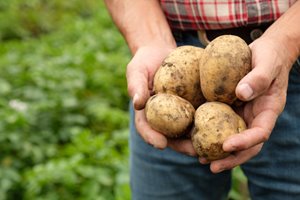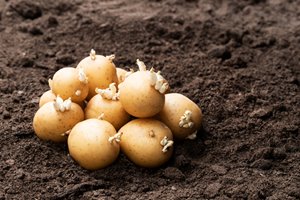Potatoes are a versatile addition to any meal and a mainstay of many dishes, from bangers and mash to the classic Sunday roast. Whether you love them boiled, baked, roasted or as chips, they are a welcome addition. Because they can be prepared in different ways and enjoyed at different times of the day, they can be a useful – and satisfying – crop to grow yourself.
No matter if you’re just starting out with your first vegetable patch and want to begin with growing potatoes or are introducing new crops to your established allotment and want to know how to grow potatoes successfully, we have all the help you need here in our growing guide.
For tips and ideas about growing potatoes, read on.
 How long do potatoes take to grow?
How long do potatoes take to grow?
Before you begin growing potatoes, it’s worth having an idea of how long the process takes. As with many crops, it can depend on the type of potato you’re growing. Small new potatoes can take around 10 weeks from sowing to harvest, but full-sized potatoes are ready after between 80 and 100 days, depending on the type.
To help you plan the timings, it’s important to be aware of the different potato types. These are:
· First earlies
First early potatoes – or new potatoes – tend to be used in salads and are the earliest to grow, usually maturing at around 10 weeks. Some can take 12 weeks to be ready, however. Potato varieties that are classed as first earlies include Orla, Rocket and Red Duke of York.
· Second earlies
As their name suggests, second earlies take between 14 and 16 weeks to mature. Again, these often work well in salads. The types of potatoes that are classed as second earlies include Maris Peer and Charlotte.
· Maincrop potatoes
When you’re planning how you want to grow your potatoes, if you imagine growing ones that are ideal for baking then this is the category for your vegetable patch. Maincrops are the largest potatoes you can grow and take from 16 to 22 weeks to be ready for harvesting. Maincrop varieties include the King Edward, Desiree, Maris Piper and Pink Fir Apple.
Knowing what type of potatoes you’d like to grow is a great starting point. As time goes on you might want to try planting a mixture of earlies and maincrops but starting with one specific type will give you a chance to get used to the growing process.
Additionally, the type you choose will dictate when in the year you plant the potatoes, how to set them out and when to harvest them.
When to plant your potatoes
If you’re trying to decide when you want to plant your potatoes, here is how to plan it out by potato type:
· First earlies – plant these in late March
· Second earlies – these should be planted early to mid-April
· Maincrops – plant maincrops mid to late April
There are other factors to consider when deciding when to plant your potatoes. Your UK location, for instance, can have a major effect on timings. For instance, if you’re in the cooler north, you might need to plant slightly later in the year. In the milder south, you might want to adjust your timings to be a little earlier.
 Growing potatoes: before you plant
Growing potatoes: before you plant
Once you’ve decided which type you’d like to grow first and have an idea of the best time to plant potatoes, you can begin the growing process. Growing potatoes begins with ‘seed’ potatoes, which look like typical potatoes but have been marked as virus-free.
It’s best to wait until the seed potatoes have sprouted a little before you plant them. This is known as ‘chitting’. To do this, keep them indoors and stand them in trays with the rose end facing upwards. The rose end is the end of the potato with the higher number of dents, or eyes.
Keep them in a light space away from frost until the shoots are around 1 inch long. If you’ve opted to grow earlies, remove the smaller shoots and leave four tubers per potato.
 Where to plant your potatoes
Where to plant your potatoes
When they are ready and have shoots, you can concentrate on planting the seed potatoes. Pop them in rich soil and add in garden compost to make sure they can access nutrients. Place them in an open, sunny location. Potatoes love the sunlight and don’t do well in frosty climates.
They also love to be spaced out, which can make it tricky to decide where to plant them. Maincrop potatoes grow well in the ground and early potatoes grow well in large pots and bags. This is worth considering when growing potatoes in a polytunnel, where pots and bags can be easily added.
There are several reasons why you might choose to grow potatoes in a polytunnel. For instance, they’ll be protected from frosty conditions. Additionally, it’s easier to control growing cycles and plan out storage in a polytunnel. Here, staging or raised beds can be used to maximise space and help you work out where you want your earlies to be and where you’d like to grow your maincrops.
It’s important you know how far apart to space your potatoes because this will help you plot out where everything goes in your polytunnel. Again, this will depend on the type of potato you’re growing:
· First earlies – plant 30cm apart and at around 12cm deep. Leave 60cm between rows.
· Second earlies – these should be planted in the same way as first earlies.
· Maincrops – maincrops need a lot of space. Allow for planting 40cm apart at a depth of 12cm in rows that are 75cm apart.
Harvest times
If we follow the general planting months listed above, harvest times when growing potatoes should be as follows:
· First early potatoes – should be ready in June and July
· Second earlies – are usually ready in July and August
· Maincrops – these can be harvested from late August until October
Once you’ve harvested your crops, you can prepare the soil for the next round of potatoes.
Get in touch
To choose the perfect polytunnel for growing potatoes in or select the staging you might need, look at the range available at www.premierpolytunnels.co.uk. If you have any questions, contact us on 01282 811250 or email info@premierpolytunnels.co.uk and we’ll be happy to help.